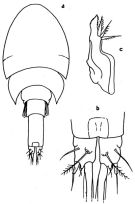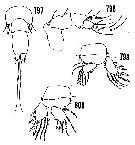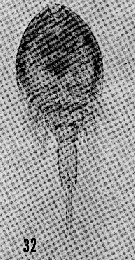|
|
 |
|
Cyclopoida ( Order ) |
|
|
|
Clausidiidae ( Family ) |
|
|
|
Saphirella ( Genus ) |
|
|
| |
Saphirella tropica Wolfenden, 1905 (F) | |
| | | | | | | Ref.: | | | Wolfenden, 1905 (1906) (p.1030, figs.); Farran, 1936 a (p.139, figs.); Nicholls, 1944 (p.50, 51, Rem.); Owre & Foyo, 1967 (p.109, figs.F); Gooding, 1988 (p.365) |  issued from : G.P. Farran in Great Barrier Reef Expedition 1928-29. Scientific Reports, V, No.3. Copepoda. 1936 [p.140, Fig.30]. Copepodite stage: a, habitus (dorsal); b, caudal rami (dorsal); c, Md (taken from a specimen from Christmas Island).
|
 issued from : H.B. Owre & M. Foyo in Fauna Caribaea, 1, Crustacea, 1: Copepoda. Copepods of the Florida Current. 1967. [p.110, Figs.797-800]. Female: 797, urosome; 798, A2; 799, P1; 800, P2.
|
 issued from : H.B. Owre & M. Foyo in Fauna Caribaea, 1, Crustacea, 1: Copepoda. Copepods of the Florida Current. 1967. [p.15, Fig.32]. Female (from 15°00'N, 67°05'W): 32, habitus (dorsal). Total length = 1.003- 1.118 mm, Prosome: 0.544-0.611; maximum width = 0.442-0.481; Urosome = 0.408-0.455; Caudal rami = 0.051-0.052
| | | | | Compl. Ref.: | | | Bainbridge, 1972 (p.61, Appendix Table II: vertical distribution); Deevey & Brooks, 1977 (p.156, tab.2, Station "S"); Jeronimo Corral & Alvarez-Ossorio, 1978 (p.138); Palomares Garcia & Vera, 1995 (tab.1); Suarez-Morales & Gasca, 1997 (p.1525); Alvarez-Cadena & al., 1998 (t.1,2,3,4); Suarez-Morales & Gasca, 1998 a (p.112); Lopez-Ibarra & Palomares-Garcia, 2006 (p.63, Tabl. 1, seasonal abundance vs El-Niño); Morales-Ramirez & Suarez-Morales, 2008 (p.524); Medellin-Mora & Navas S., 2010 (p.265, Tab. 2); Lavaniegos & al., 2012 (p. 11, Appendix); in CalCOFI regional list (MDO, Nov. 2013; M. Ohman, comm. pers.); Marques-Rojas & Zoppi de Roa, 2017 (p.495, Table 1); Jerez-Guerrero & al., 2017 (p.1046, Table 1: temporal occurrence) | | | | NZ: | 7 | | |
|
Distribution map of Saphirella tropica by geographical zones
|
| | | | | | | Loc: | | | G. of Guinea, Caribbean Sea, Caribbean Colombia (San Andrés y Providencia), Bahia de Mochima (Venezuela), Yucatan, Sargasso Sea (Bermuda: Station "S"), NW Spain (Ria de Arosa), Maldive Is., Christmas Island, Australia (Great Barrier, off Newcastle), W Baja California (Magdalena Bay: rare), G. of California (Bahia de los Angeles), W Costa Rica, Bahia Cupica (Colombia) | | | | N: | 24 | | | | Lg.: | | | (34) F: 1,12; (78) F: 1,2; (140) F: 1,118-1,003; {F: 1,003-1,118} | | | | Rem.: | Depth in Florida area: 100, 170 and 877 m. Overall Depth Range in Sargasso Sea: 500-1500 m (Deevey & Brooks, 1977, Station "S"); | | | Last update : 05/04/2018 | |
| | | | Whilst analysing our continuous plankton recorder tows along the east coast of Australia we found a specimen that we could not identify. On asking advice we were told that it was a juvenile hemicyclops, previously known as Saphirella. I believe that Saphirella is now old name for what is now generally considered to be a juvenile of Hemicyclops (a copepod generally commensal on polychaetes, but the juveniles swim free!)
Hiroshi Itoh from Japan has studied the taxon in great detail (its biology, ecology, and taxonomy) and published several papers on this topic [starting from 1991 (Itoh & Nishida, Bull. Plankton Soc. Japan, Spec. Vol.: 397-403) up to 2008 (Plankton Benthos Res. 3:189-201) and incl. his thesis in 2003]
You may want to consider reviewing the inclusion of Saphirella vs hemicyclops.
Thanks,
Claire | |
|
|
|
 Any use of this site for a publication will be mentioned with the following reference : Any use of this site for a publication will be mentioned with the following reference :
Razouls C., Desreumaux N., Kouwenberg J. and de Bovée F., 2005-2025. - Biodiversity of Marine Planktonic Copepods (morphology, geographical distribution and biological data). Sorbonne University, CNRS. Available at http://copepodes.obs-banyuls.fr/en [Accessed December 04, 2025] © copyright 2005-2025 Sorbonne University, CNRS
|
|
 |
 |






